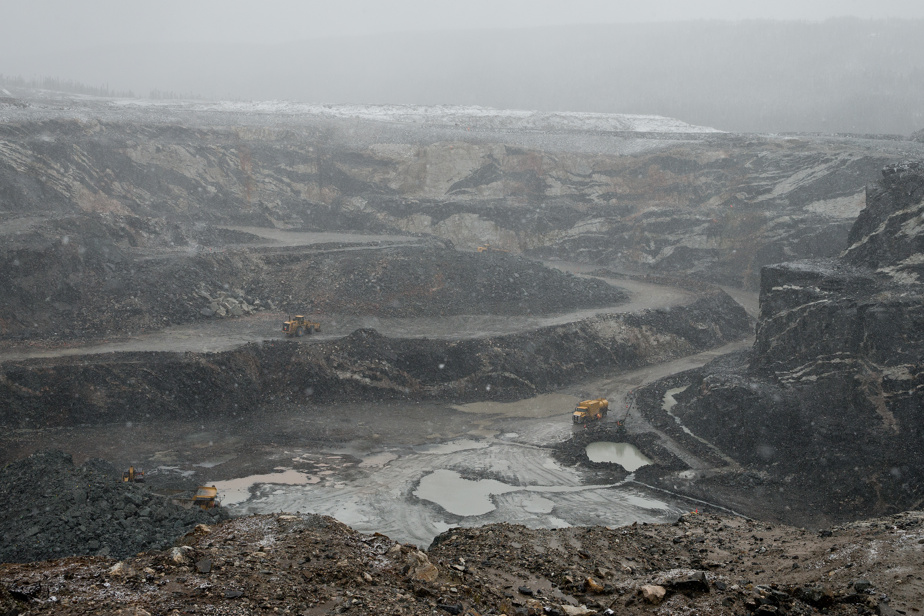Symbol of the relaunch of the Northern Plan, the Renard diamond mine will once again cause taxpayers to lose millions. In the red, it ceases its activities and protects itself from its creditors. For the Legault government, “this mine is over”.
This is the second time in four years that Stornoway has turned to Companies’ Creditors Arrangement Act (LACC). Around 425 employees learned on Friday that they were losing their livelihood. The mining company will try to find a new owner. One thing is certain, Quebec, which will suffer further losses, will not hand over any money.
“I think that this mine is finished,” said the Minister of Economy and Innovation, Pierre Fitzgibbon, on the sidelines of an economic announcement in Candiac. It’s sad. When minerals are extracted […] and that we [les] exports, we are vulnerable to the price of convenience. This is what happened with Stornoway. »
Located in the Eeyou Istch territory, in Nord-du-Québec, the mining complex restarted its activities in 2020. Diamants Stornoway belongs to Osisko, Investissement Québec (IQ), the Caisse de dépôt et placement du Québec (CDPQ) and Triple Flag.
After the company generated profits of 42 million in 2022, the financial situation deteriorated rapidly. By the end of September, losses totaled $13 million, according to court documents seen by The Press. Debts reached 310 million. The main creditors were the financial arm of the Quebec state (120 million), Osisko (59 million) and the CDPQ (25 million).
Diamond prices have fallen in response to competition from synthetic stones popular with millennials of engagement age. The slump is such that India, a major global polishing center, has imposed a moratorium on imports of rough diamonds until December 15 in the hope of having its stock. This was the final blow to Stornoway.
“Historically, India has purchased 90% of the world’s rough diamonds,” says Stornoway. This unilateral and permanent freeze on imports has resulted in a considerable loss of revenue and has seriously hampered our ability to sell inventory at acceptable and profitable prices. »
While the average price of a jewelry diamond was close to US$120 per carat last March, it had plunged to trade around US$81.50 per carat in September. Stornoway expected an average price of $112.50 per carat for the year. As of the first half of 2023, Stornoway has sold 938,000 carats at an average price of US$110 per carat (C$148). Its production cost is not public. In 2022, the average price obtained was US$125.
A shock
At the mining company, the president and CEO, Patrick Sévigny, was not available for interviews on Friday. In Chibougamau, there is surprise and amazement. Its mayor, Manon Cyr, affirms that there were no warning signals.
“Approximately 120 of Stornoway’s jobs are held by residents of Jamésie and Baie-James,” she emphasized, during a telephone interview, in which she hoped that the mine would survive. Diamonds provide mineral diversity to our region, especially present in gold and copper, which makes the regional economy more resilient. »
Only 75 employees will remain on the mine site to avoid deterioration of the installations.
For Michel Jébrak, professor in the department of Earth and atmospheric sciences at UQAM, the mining complex should generate interest. It’s all a question of price.
“Canada has opened beautiful diamond mines,” he said. It is a field of diamondiferous kimberlites which was discovered in Renard. There are quality stones there. It’s positive. With the road that exists, the existing assets on site and a significant discount, it will interest people. »
Financial pit
The company’s first disaster had already cost IQ, the CDPQ and the FTQ Solidarity Fund several tens of millions. As of December 31, CDPQ’s investment in mining was worth no more than 5 million.
“The Caisse has supported Stornoway since the very beginning and has supported the company through the various challenges of recent years,” underlines its spokesperson, Kate Monfette. We will let the legal process take its course. »
These sums lost by the three institutions do not take into account the public funding of around 400 million aimed at building the road section connecting the mine to Route 167.
Public losses from the first Stornoway debacle
- Investissement Québec: 110 million
- Caisse de dépôt et placement du Québec: 42 million
- FTQ Solidarity Fund: 50 million
Are currently at risk
- Investissement Québec: 120 million
- Caisse de dépôt et placement du Québec: 25 million
The battery sector is not at risk
According to Minister Fitzgibbon, the failure of Stornoway proves that his government’s integrated approach to the lithium sector and other critical minerals is far preferable to what we see in the extraction of other minerals exported without being transformed here. “Converting critical minerals to Quebec” is “the right strategy,” he says, since mining production is integrated into an entire supply chain, downstream, and therefore less sensitive to market fluctuations than minerals like “diamonds”. , which we mine and send elsewhere at determined prices to the major diamond exchanges such as Antwerp, London, New York, Tel Aviv and Bombay. “It’s a commodity market. This will not happen with lithium,” the minister said.
Denis Arcand, The Press
Learn more
-
- 2016
- Year the diamond mine was inaugurated
Government of Quebec
- 52%
- Percentage of Stornoway owned by Investissement Québec and the Caisse de dépôt et placement du Québec
THE PRESS
